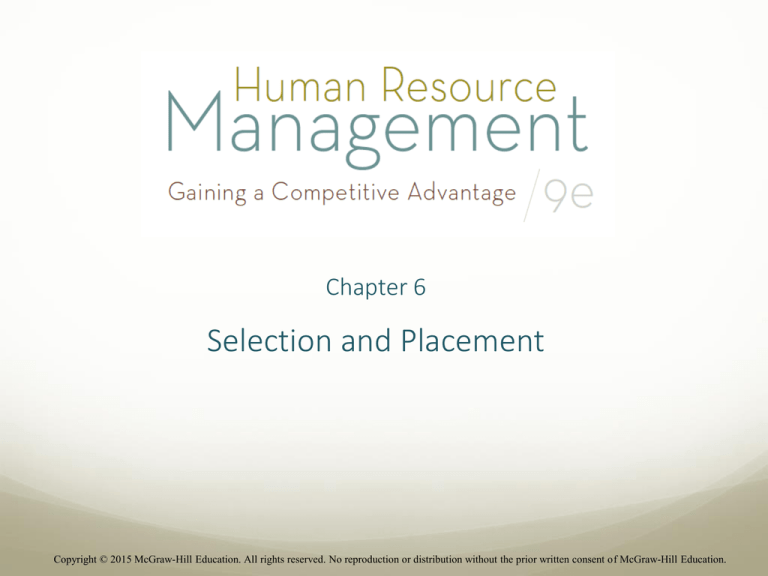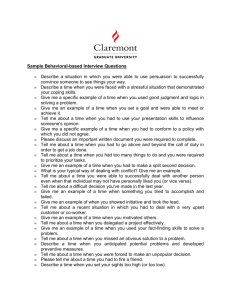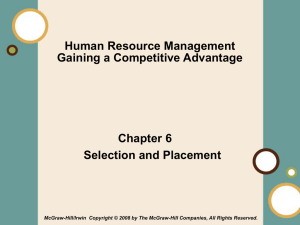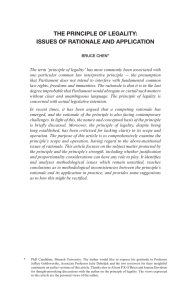
Chapter 6
Selection and Placement
Copyright © 2015 McGraw-Hill Education. All rights reserved. No reproduction or distribution without the prior written consent of McGraw-Hill Education.
5 Evaluation Selection Method Standards
1. Reliability
2. Validity
3. Generalizability
4. Utility
5. Legality
6-2
Legality
All selection methods must conform to existing
laws and legal precedents.
Three acts form the basis for a majority of suits
filed by job applicants:
Civil Rights Act of 1991 and 1964
Age Discrimination in Employment Act of 1967
Americans with Disabilities Act of 1991
6-3
Types of Selection Methods
JOBS
6-4
Interviews
Selection interviews-a dialogue initiated by one or
more persons to gather information and evaluate the
applicant’s qualifications for employment.
To increase an interview’s utility:
Interviews should be structured, standardized, and focused
on goals oriented to skills and observable behaviors.
Interviewers should be able to quantitatively rate each
interview.
Interviewers should have a structured note-taking system
that will aid recall to satisfying ratings.
6-5
Experience-Based
Situational Interview Items
Table 6.2
Experience Based
Motivating employees:
“Think about an instance when you had to
motivate an employee to perform a task
that he or she disliked but that you needed
to have done. How did you handle that
situation?”
Resolving conflict:
“What was the biggest difference of opinion
you ever had with a co-worker? How did
you resolve that situation?”
Overcoming resistance
to change:
“What was the hardest change you ever had
to bring about in a past job, and what did
you do to get the people around you to
change their thoughts or behaviors?”
6-6
Future Oriented
Situational Interview Items
Table 6.2
Future Oriented
Motivating employees:
Suppose you were working with an employee
who you knew greatly disliked performing a
particular task. You needed to get this task
completed, however, and this person was the
only one available to do it. What would you
do to motivate that person?”
Resolving conflict:
““Imagine that you and a co-worker disagree
about the best way to handle an absenteeism
problem with another member of your team.
How would you resolve that situation?”
Overcoming resistance
to change:
“Suppose you had an idea for change in work
procedures that would enhance quality, but
some members of your work group were
hesitant to make the change. What would
you do in that situation?”
6-7
Big 5 Dimensions
of Personality Inventories
6-8
Emotional Intelligence
6-9
Summary of Selection Methods
JOBS
6-10
Summary
Job applicants and an organization’s viability are affected by
decisions regarding who is accepted and rejected for positions.
Five standards should conform: reliability, validity,
generalizability, utility and legality.
Managerial assessment centers use many different forms of
tests over a two or three day period to learn as much as
possible about candidates for important executive positions.
Validity associated with judicious use of multiple tests is higher
than for tests used in isolation.
6-11








